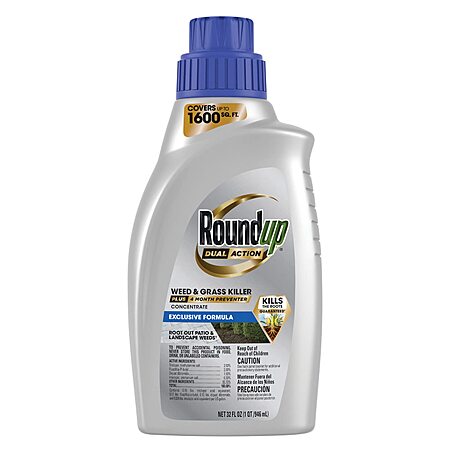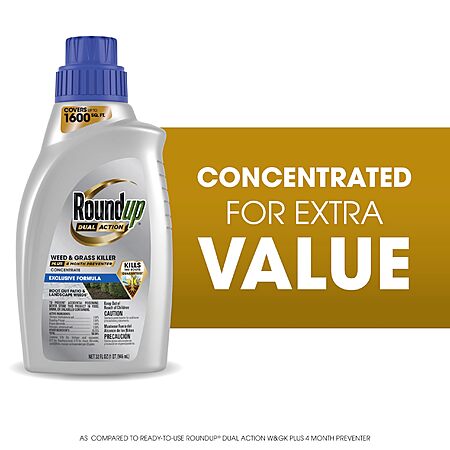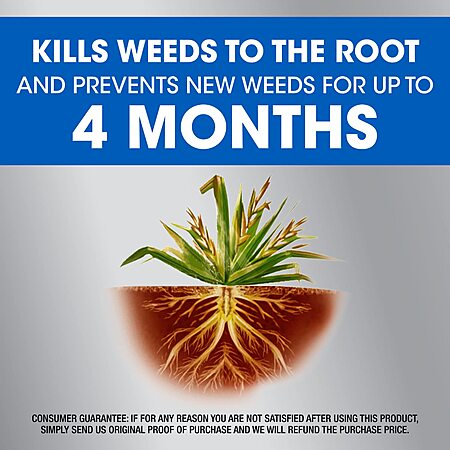expiredRokket | Staff posted Jun 27, 2025 05:21 AM
Item 1 of 4
Item 1 of 4
expiredRokket | Staff posted Jun 27, 2025 05:21 AM
32-Oz Roundup Dual Action Weed & Grass Killer Plus 4 Month Preventer Concentrate
$22
$38
42% offAmazon
Visit AmazonGood Deal
Bad Deal
Save
Share




Leave a Comment
Top Comments
Roundup products manufactured by Bayer-Monsanto kill exposed bumblebees at high rates, according to a new study published in the Journal of Applied Ecology, which points to undisclosed inert ingredients (those that typically make up a majority of the product formulation) as the primary culprit. Roundup products have become synonymous with their main active ingredient glyphosate, but Bayer-Monsanto has been quietly reformulating its flagship product with different herbicides in a likely attempt to rebrand as glyphosate cancer lawsuits drag down the company's performance. The new study reveals that these new Roundup products present the same hazards to pollinators as glyphosate-based formulations, raising important questions about the pesticide regulatory process.
Researchers based at Royal Holloway University of London, UK conducted the present study to better understand the hazards posed by herbicides often characterized as "bee safe" to the public. To do so, 10 healthy bumblebee (Bombus spp) colonies were retained, split into small groups, and sprayed with a particular herbicide. Four different herbicide products were employed, including: i) Fast Action Roundup® Ready‐To‐Use (containing glyphosate); ii) Roundup® Speed Ultra (containing acetic acid and no glyphosate); iii) Weedol® Gun! Rootkill Plus (containing glyphosate) and; iv) Roundup® ProActive (contains glyphosate – for agricultural use). Each group of bumblebees received two sprays of the ready to use substance, or in the case of the agricultural Roundup, received an amount similar to that applied when farming. Although these amounts were not what is considered field realistic, the aim of the study was to determine the harm pollinators experience from direct exposure to a product claimed to be safe for pollinators. In the authors' words, "Fundamentally, our experiment was designed to enable the detection of hazardous effects from substances previously reported to be non‐hazardous."
Interestingly, the "no glyphosate" formulation of Roundup being sold in the UK and European Union is different than "no glyphosate" formulations being sold in the United States. In the U.S., Bayer-Monsanto is selling a product line called Roundup® for Lawns which contains four different main active ingredients: dicamba, MCPA, quinclorac, and sulfenzatrone. The UK/EU version of the product appears to only contain acetic acid (vinegar), a least toxic substance that presents moderate hazards to pollinators from exposure. However, the results raise the likelihood that it is primarily the so called "inert" materials not disclosed on the Roundup label that are harming pollinators.
Bumblebees sprayed with consumer use Roundup Ready-To-Use (contains glyphosate) experienced a shocking 94% mortality. Subsequent experiments were conducted at lower application rates for that product, and significant mortality was seen for the 1:1 dilution (98% mortality) as well as the 1:3 dilution rate (78% mortality). The agricultural use Roundup Proactive (contains glyphosate) saw lower rates of death at 30%. Weedol, a glyphosate-based consumer product, displayed a mortality rate (6%) similar to the unexposed control group of bumblebees (4%). However, Roundup Speed Ultra (no glyphosate) was found to kill 96% of exposed pollinators.
The combined results indicate a serious problem with Roundup formulations. "Together, this demonstrates that the co‐formulants in these Roundup® products, not the active ingredient glyphosate, are driving mortality," the researchers indicate. The scientists note that surfactants or other inert ingredients may be smothering exposed pollinators, noting that only Roundup products caused "comprehensive matting of bee body hair." The authors' write, "We suggest that the mechanism driving this mortality may be surfactants in the formulations blocking the tracheal system of the bees, which is essential for gas exchange."
While the evidence appears to strongly favor inerts as the primary culprit in this research, it is worth noting that studies have found technical grade (pure) glyphosate can harm pollinators. A 2018 study found that it disrupts honey bee microbiota, and a 2015 study found that it result in sublethal effects on honey bee navigation and foraging success.
Inerts, like surfactants, emulsifiers, and other co-formulants, or not required to undergo the same level of scrutiny for the harm they may cause – as strong regulations for these other ingredients are lacking on both sides of the Atlantic. The U.S. Environmental Protection Agency has refused to disclose these ingredients to the public on the label of pesticide products despite repeated attempts by Beyond Pesticides and other advocacy organizations to petition the agency.
This is not the first time inert ingredients have been cited for their danger to pollinators. A 2014 study found that pesticide mixtures and inert ingredients – particularly one inert able to be identified by researchers, N-methyl-2-pyrrolidone – resulted in high rates of larval honey bee mortality. In 2017, a study published in the journal Nature found that a specific inert called Slygard 309, an organosilicone surfactant, increased honey bee's susceptibility to a deadly virus.
The latest concerning news on inert ingredients revolves around widespread findings that PFAS chemicals are contaminating pesticide products. A 2017 study detected PFAS chemicals in bee hives, and a study published earlier this month indicates that PFOS (a certain type of PFAS chemical) can increase honey bee mortality and halt brood development.
It is little wonder why regulatory agencies have been brought to task by the scientific community for inaction on inert ingredients. A 2018 report published in Frontiers in Public Health reviewed the literature on commonly used formulations of glyphosate, finding a wide range of different inert ingredients and toxicity levels from different glyphosate products. Despite this variability, researchers note how many studies conducting research on glyphosate as the active ingredient actually use formulated products in their studies, potentially botching results.
As the authors of that study recommend, regulatory agencies should not be treating inert ingredients separately from active ingredients. When both active and inert ingredients can be equally hazardous, there is no reason to ignore up to 99% of a pesticide's formulation simply because the manufacturer claims that only the active ingredient will harm the target pest.
btw, if you going to cut and paste crap you read on the interwub, cite the source. there are so much shit junk science out there.
Any time doofus cite roundup and cancer in the same paragraph, you know the kind of junk info they consumes. here's a better source that include real evidence:
https://sciencebasedmed
30 Comments
Sign up for a Slickdeals account to remove this ad.
Sorry, this item cannot be shipped to your selected address due to local laws or Amazon policy. Please change the shipping address or delete the item from your order.
Our community has rated this post as helpful. If you agree, why not thank Manton10
Roundup products manufactured by Bayer-Monsanto kill exposed bumblebees at high rates, according to a new study published in the Journal of Applied Ecology, which points to undisclosed inert ingredients (those that typically make up a majority of the product formulation) as the primary culprit. Roundup products have become synonymous with their main active ingredient glyphosate, but Bayer-Monsanto has been quietly reformulating its flagship product with different herbicides in a likely attempt to rebrand as glyphosate cancer lawsuits drag down the company's performance. The new study reveals that these new Roundup products present the same hazards to pollinators as glyphosate-based formulations, raising important questions about the pesticide regulatory process.
Researchers based at Royal Holloway University of London, UK conducted the present study to better understand the hazards posed by herbicides often characterized as "bee safe" to the public. To do so, 10 healthy bumblebee (Bombus spp) colonies were retained, split into small groups, and sprayed with a particular herbicide. Four different herbicide products were employed, including: i) Fast Action Roundup® Ready‐To‐Use (containing glyphosate); ii) Roundup® Speed Ultra (containing acetic acid and no glyphosate); iii) Weedol® Gun! Rootkill Plus (containing glyphosate) and; iv) Roundup® ProActive (contains glyphosate – for agricultural use). Each group of bumblebees received two sprays of the ready to use substance, or in the case of the agricultural Roundup, received an amount similar to that applied when farming. Although these amounts were not what is considered field realistic, the aim of the study was to determine the harm pollinators experience from direct exposure to a product claimed to be safe for pollinators. In the authors' words, "Fundamentally, our experiment was designed to enable the detection of hazardous effects from substances previously reported to be non‐hazardous."
Interestingly, the "no glyphosate" formulation of Roundup being sold in the UK and European Union is different than "no glyphosate" formulations being sold in the United States. In the U.S., Bayer-Monsanto is selling a product line called Roundup® for Lawns which contains four different main active ingredients: dicamba, MCPA, quinclorac, and sulfenzatrone. The UK/EU version of the product appears to only contain acetic acid (vinegar), a least toxic substance that presents moderate hazards to pollinators from exposure. However, the results raise the likelihood that it is primarily the so called "inert" materials not disclosed on the Roundup label that are harming pollinators.
Bumblebees sprayed with consumer use Roundup Ready-To-Use (contains glyphosate) experienced a shocking 94% mortality. Subsequent experiments were conducted at lower application rates for that product, and significant mortality was seen for the 1:1 dilution (98% mortality) as well as the 1:3 dilution rate (78% mortality). The agricultural use Roundup Proactive (contains glyphosate) saw lower rates of death at 30%. Weedol, a glyphosate-based consumer product, displayed a mortality rate (6%) similar to the unexposed control group of bumblebees (4%). However, Roundup Speed Ultra (no glyphosate) was found to kill 96% of exposed pollinators.
The combined results indicate a serious problem with Roundup formulations. "Together, this demonstrates that the co‐formulants in these Roundup® products, not the active ingredient glyphosate, are driving mortality," the researchers indicate. The scientists note that surfactants or other inert ingredients may be smothering exposed pollinators, noting that only Roundup products caused "comprehensive matting of bee body hair." The authors' write, "We suggest that the mechanism driving this mortality may be surfactants in the formulations blocking the tracheal system of the bees, which is essential for gas exchange."
While the evidence appears to strongly favor inerts as the primary culprit in this research, it is worth noting that studies have found technical grade (pure) glyphosate can harm pollinators. A 2018 study found that it disrupts honey bee microbiota, and a 2015 study found that it result in sublethal effects on honey bee navigation and foraging success.
Inerts, like surfactants, emulsifiers, and other co-formulants, or not required to undergo the same level of scrutiny for the harm they may cause – as strong regulations for these other ingredients are lacking on both sides of the Atlantic. The U.S. Environmental Protection Agency has refused to disclose these ingredients to the public on the label of pesticide products despite repeated attempts by Beyond Pesticides and other advocacy organizations to petition the agency.
This is not the first time inert ingredients have been cited for their danger to pollinators. A 2014 study found that pesticide mixtures and inert ingredients – particularly one inert able to be identified by researchers, N-methyl-2-pyrrolidone – resulted in high rates of larval honey bee mortality. In 2017, a study published in the journal Nature found that a specific inert called Slygard 309, an organosilicone surfactant, increased honey bee's susceptibility to a deadly virus.
The latest concerning news on inert ingredients revolves around widespread findings that PFAS chemicals are contaminating pesticide products. A 2017 study detected PFAS chemicals in bee hives, and a study published earlier this month indicates that PFOS (a certain type of PFAS chemical) can increase honey bee mortality and halt brood development.
It is little wonder why regulatory agencies have been brought to task by the scientific community for inaction on inert ingredients. A 2018 report published in Frontiers in Public Health reviewed the literature on commonly used formulations of glyphosate, finding a wide range of different inert ingredients and toxicity levels from different glyphosate products. Despite this variability, researchers note how many studies conducting research on glyphosate as the active ingredient actually use formulated products in their studies, potentially botching results.
As the authors of that study recommend, regulatory agencies should not be treating inert ingredients separately from active ingredients. When both active and inert ingredients can be equally hazardous, there is no reason to ignore up to 99% of a pesticide's formulation simply because the manufacturer claims that only the active ingredient will harm the target pest.
btw, if you going to cut and paste crap you read on the interwub, cite the source. there are so much shit junk science out there.
Any time doofus cite roundup and cancer in the same paragraph, you know the kind of junk info they consumes. here's a better source that include real evidence:
https://sciencebasedmed
Sign up for a Slickdeals account to remove this ad.
Our community has rated this post as helpful. If you agree, why not thank adams551
Glyphosate is no longer in Roundup. There is so much fear mongering when it comes to glyphosate, but the reality is that it has passed through nearly every countries regulatory system and multiple studies show it's safe use even when tested in levels 10x higher than normal exposure rates. However no one bats an eye at landfills (filled with literally everything leeching into the environment) and emissions and waste products from vehicles.
Roundup products manufactured by Bayer-Monsanto kill exposed bumblebees at high rates, according to a new study published in the Journal of Applied Ecology, which points to undisclosed inert ingredients (those that typically make up a majority of the product formulation) as the primary culprit. Roundup products have become synonymous with their main active ingredient glyphosate, but Bayer-Monsanto has been quietly reformulating its flagship product with different herbicides in a likely attempt to rebrand as glyphosate cancer lawsuits drag down the company's performance. The new study reveals that these new Roundup products present the same hazards to pollinators as glyphosate-based formulations, raising important questions about the pesticide regulatory process.
Researchers based at Royal Holloway University of London, UK conducted the present study to better understand the hazards posed by herbicides often characterized as "bee safe" to the public. To do so, 10 healthy bumblebee (Bombus spp) colonies were retained, split into small groups, and sprayed with a particular herbicide. Four different herbicide products were employed, including: i) Fast Action Roundup® Ready‐To‐Use (containing glyphosate); ii) Roundup® Speed Ultra (containing acetic acid and no glyphosate); iii) Weedol® Gun! Rootkill Plus (containing glyphosate) and; iv) Roundup® ProActive (contains glyphosate – for agricultural use). Each group of bumblebees received two sprays of the ready to use substance, or in the case of the agricultural Roundup, received an amount similar to that applied when farming. Although these amounts were not what is considered field realistic, the aim of the study was to determine the harm pollinators experience from direct exposure to a product claimed to be safe for pollinators. In the authors' words, "Fundamentally, our experiment was designed to enable the detection of hazardous effects from substances previously reported to be non‐hazardous."
Interestingly, the "no glyphosate" formulation of Roundup being sold in the UK and European Union is different than "no glyphosate" formulations being sold in the United States. In the U.S., Bayer-Monsanto is selling a product line called Roundup® for Lawns which contains four different main active ingredients: dicamba,MCPA, quinclorac, and sulfenzatrone. The UK/EU version of the product appears to only contain acetic acid (vinegar), a least toxic substance that presents moderate hazards to pollinators from exposure. However, the results raise the likelihood that it is primarily the so called "inert" materials not disclosed on the Roundup label that are harming pollinators.
Bumblebees sprayed with consumer use Roundup Ready-To-Use (contains glyphosate) experienced a shocking 94% mortality. Subsequent experiments were conducted at lower application rates for that product, and significant mortality was seen for the 1:1 dilution (98% mortality) as well as the 1:3 dilution rate (78% mortality). The agricultural use Roundup Proactive (contains glyphosate) saw lower rates of death at 30%. Weedol, a glyphosate-based consumer product, displayed a mortality rate (6%) similar to the unexposed control group of bumblebees (4%). However, Roundup Speed Ultra (no glyphosate) was found to kill 96% of exposed pollinators.
The combined results indicate a serious problem with Roundup formulations. "Together, this demonstrates that the co‐formulants in these Roundup® products, not the active ingredient glyphosate, are driving mortality," the researchers indicate. The scientists note that surfactants or other inert ingredients may be smothering exposed pollinators, noting that only Roundup products caused "comprehensive matting of bee body hair." The authors' write, "We suggest that the mechanism driving this mortality may be surfactants in the formulations blocking the tracheal system of the bees, which is essential for gas exchange."
While the evidence appears to strongly favor inerts as the primary culprit in this research, it is worth noting that studies have found technical grade (pure) glyphosate can harm pollinators. A 2018 study found that it disrupts honey bee microbiota, and a 2015 study found that it result in sublethal effects on honey bee navigation and foraging success.
Inerts, like surfactants, emulsifiers, and other co-formulants, or not required to undergo the same level of scrutiny for the harm they may cause – as strong regulations for these other ingredients are lacking on both sides of the Atlantic. The U.S. Environmental Protection Agency has refused to disclose these ingredients to the public on the label of pesticide products despite repeated attempts by Beyond Pesticides and other advocacy organizations to petition the agency.
This is not the first time inert ingredients have been cited for their danger to pollinators. A 2014 study found that pesticide mixtures and inert ingredients – particularly one inert able to be identified by researchers, N-methyl-2-pyrrolidone – resulted in high rates of larval honey bee mortality. In 2017, a study published in the journal Nature found that a specific inert called Slygard 309, an organosilicone surfactant, increased honey bee's susceptibility to a deadly virus.
The latest concerning news on inert ingredients revolves around widespread findings that PFAS chemicals are contaminating pesticide products. A 2017 study detected PFAS chemicals in bee hives, and a study published earlier this month indicates that PFOS (a certain type of PFAS chemical) can increase honey bee mortality and halt brood development.
It is little wonder why regulatory agencies have been brought to task by the scientific community for inaction on inert ingredients. A 2018 report published in Frontiers in Public Health reviewed the literature on commonly used formulations of glyphosate, finding a wide range of different inert ingredients and toxicity levels from different glyphosate products. Despite this variability, researchers note how many studies conducting research on glyphosate as the active ingredient actually use formulated products in their studies, potentially botching results.
As the authors of that study recommend, regulatory agencies should not be treating inert ingredients separately from active ingredients. When both active and inert ingredients can be equally hazardous, there is no reason to ignore up to 99% of a pesticide's formulation simply because the manufacturer claims that only the active ingredient will harm the target pest.
This has less than 0.010 diquat and none of the other active ingredients in the article you copy/pasted. As a licensed pesticide applicator and IPM certified (Integrated pest management) these knee jerk post regarding the brand name Roundup and glyphosate being lumped together does more harm and keeps spreading disinformation.
Sign up for a Slickdeals account to remove this ad.
Sorry, this item cannot be shipped to your selected address due to local laws or Amazon policy. Please change the shipping address or delete the item from your order.
Just ordered from Walmart in California. Will be delivered tormorrow
Leave a Comment